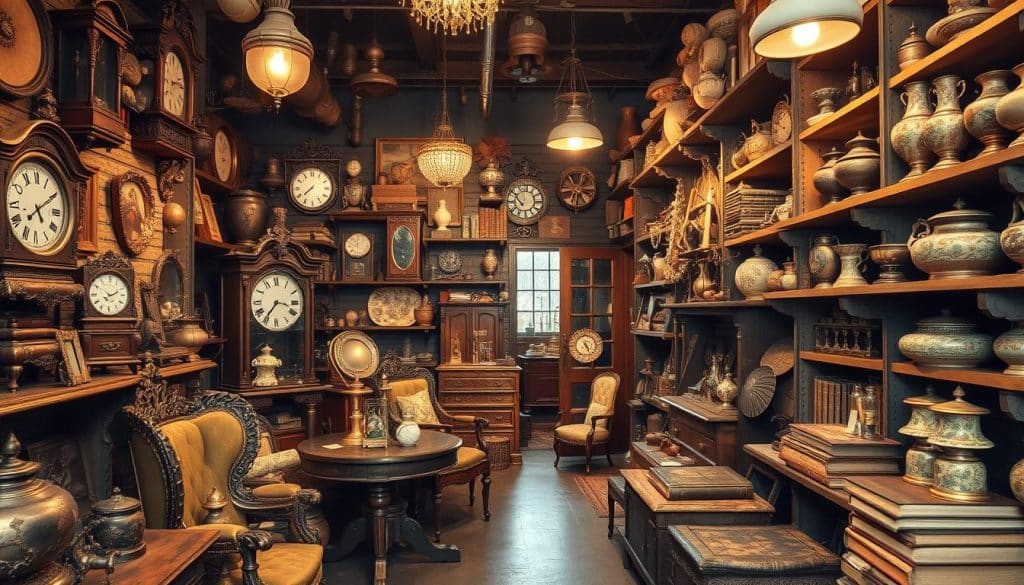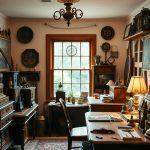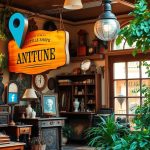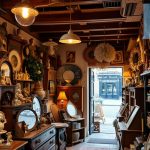The world of antique stock is not just interesting but also very valuable today. To get antiques, you need to know how to find them and tell real items from fake ones. This article will explore how to find antiques, the best ways to get them, and how to work with antique dealers. It’s for anyone interested in collecting antiques in the UK, whether you’re just starting or have been collecting for years.
Key Takeaways
- Antique stock plays a vital role in today’s collectibles market.
- Understanding sourcing antiques is essential for successful acquisition.
- Building relationships with antique dealers can enhance your collection.
- Knowledge of authentic items is crucial in avoiding reproductions.
- Effective sourcing techniques can lead to valuable finds.
The Importance of Antique Stock in Today’s Market
Antiques are very valuable today, linking history with modern style. They are not just beautiful but also carry stories of old craftsmanship. Collectors love these unique items, turning their homes into personal art galleries.
Young people, especially millennials, are now interested in antiques. They value sustainability and authenticity. This makes antiques more appealing to them. They look for items that are not only beautiful but also have a history and are good for the planet.
Collectors want high-quality and unique antiques more than ever. Traditional markets are steady, but new trends like upcycled and artisanal items are growing. Knowing these trends helps collectors pick pieces that will increase in value.
Understanding Antique Stock: Definitions and Categories
Understanding antique stock starts with knowing what an antique is. An item is considered an antique if it’s over 100 years old. Experts say the historical context is key to deciding if something is an antique.
Antiques include many things like furniture, fine art, ceramics, glassware, and textiles. Each type has its own market trends and value. For example, Victorian furniture can vary a lot in price based on its style and condition.
When appraising antiques, factors like provenance, rarity, and condition matter. Knowing these helps collectors and dealers make smart choices. Learning about historical eras and their market appeal can boost one’s knowledge of antiques.
| Category of Antique | Examples | Appraisal Criteria |
|---|---|---|
| Furniture | Victorian, Georgian, Edwardian | Condition, Style, Provenance |
| Fine Art | Paintings, Sculptures | Artist, Condition, Market Demand |
| Ceramics | Pottery, Porcelain | Maker, Age, Rarity |
| Glassware | Vases, Crystal | Type, Quality, Maker |
| Textiles | Quilts, Tapestries | Materials, Condition, Age |
Sourcing and Acquiring Antique Stock
Finding and buying antique items takes effort and knowing the best ways to do it. There are many places to look, like estate sales, auctions, shops, and online. Learning how to find antiques helps collectors spot valuable items and avoid fake ones.
Best Practices for Sourcing
Following the best practices is key in the antique market. Here are some important tips:
- Do your homework on the antiques you want to find.
- Set a budget to prevent spending too much.
- Check if items are real with documents or expert advice.
- Get tips from seasoned collectors and dealers.
Key Considerations for Acquiring
When buying antiques, keep these points in mind:
- Learn about the history of each piece to understand its value.
- Look closely at condition reports to ensure quality.
- Keep up with what people want in antiques.
- Work with trusted dealers for reliable deals.
Identifying Authentic Antiques: Essential Tips
It’s key to know how to spot real antiques if you want to collect them. Having a keen eye and good knowledge is vital. Start by looking for wear that shows the item is old, not just copied. Authentic antiques often have flaws that show they were made by hand.
Joining groups or talking to experts can really help you learn about antiques. Using magnifying glasses can reveal small details like maker’s marks. These can prove if an item is genuine.
Dealing with sellers who have documents like appraisals can be helpful. These documents prove the item’s value and history. Good dealers can also teach you how to spot real antiques.
Online resources and guides can also be useful. They offer photos and details to help you compare items. This makes it easier to find authentic antiques.
| Authenticity Indicators | Description |
|---|---|
| Signs of Wear | Natural ageing marks that highlight the piece’s history rather than modern replication. |
| Craftsmanship | Evidence of hand workmanship, including irregularities typical in handmade items. |
| Documentation | Appraisals or certificates that verify an item’s provenance and authenticity. |
| Expert Consultation | Seeking advice from industry professionals or recognised associations to validate pieces. |
| Research Tools | Online databases and reference guides that provide key information for comparison. |
The Role of Auctions in Antique Acquisition
Auction houses are key in the antique market, offering collectors a chance to find unique items. They have different types for various interests and budgets. Knowing about these types can make the experience better for new and experienced bidders. It’s important to use good bidding strategies to make successful purchases.
Types of Auctions to Consider
There are several auction types, each with its own setting and items. The main types are:
- Live Public Auctions: These are traditional events where people raise paddles to bid.
- Online Auctions: These are held on websites and let people bid from anywhere, reaching more people.
- Specialised Antique Auctions: These focus only on antiques, offering expert valuations and items of interest.
Strategies for Bidding Successfully
To do well in antique auctions, it’s important to have good bidding strategies. Here are some tips:
- Know the Market Value: Look up similar items to understand their fair price before bidding.
- Set a Budget: Decide how much you can spend to avoid spending too much.
- Develop Tactics: For online auctions, think about setting maximum bids to save time and control your bidding.
- Stay Composed: Keep calm and don’t let the excitement take over; patience can often lead to better deals.
Working with Antique Dealers: Building Relationships
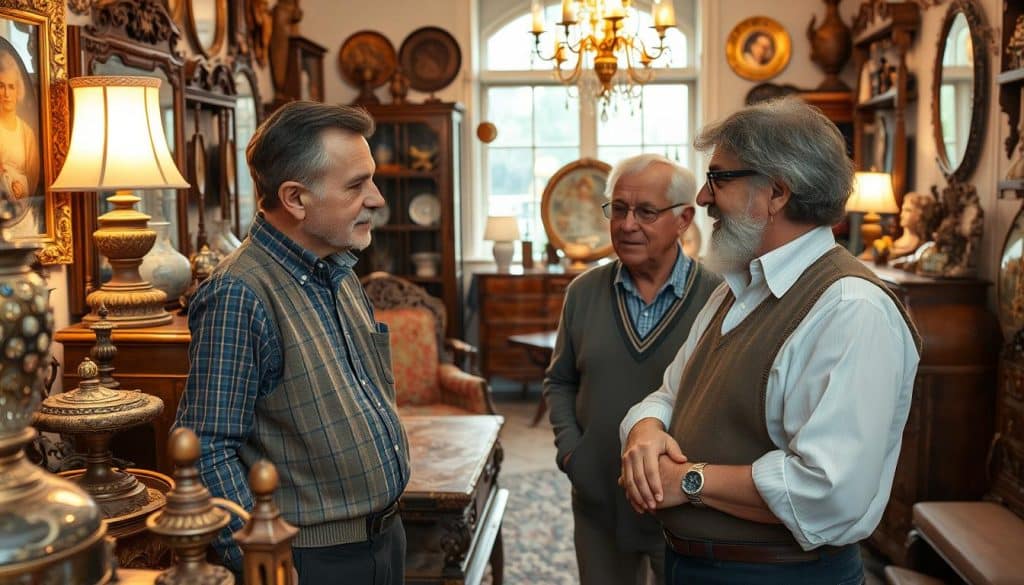
Connecting with reputable antique dealers can greatly improve your search for quality items. They know the market well, which is very useful for collectors. It’s not just good for business; it opens doors to special items and expert advice.
Going to exhibitions, fairs, and networking events is a great way to meet dealers face-to-face. Talking about what you both like builds trust. Dealers like collectors who really care about their items, leading to good deals.
- Develop personal connections with antique dealers to facilitate better communication.
- Share insights about preferred styles and collectibles, enabling tailored offerings.
- Attend industry events to strengthen professional networking and visibility.
- Seek advice and guidance, demonstrating respect for their expertise.
Knowing what a dealer has can help you find exactly what you’re looking for. It might even get you a discount. Building these relationships is key for anyone into collecting antiques.
| Benefits of Building Dealer Relationships | How to Build Relationships |
|---|---|
| Access to exclusive items | Attend antique fairs |
| Expert advice and insights | Engage in open discussions |
| Potential discounts | Share your interests |
| Better communication | Network at professional events |
Sourcing Techniques for Collectors and Dealers
Nowadays, sourcing antiques online is a hit with collectors and dealers. It lets them find a wide range of items from sellers worldwide. To make the most of these sites, it’s key to have good sourcing techniques for finding great pieces.
Using Online Platforms
Platforms like eBay and 1stDibs are goldmines for antiques. They let users sift through lots of items easily. With filters and categories, finding what you want is simpler. But, it’s crucial to check seller ratings and descriptions to be sure of the item’s real deal and condition.
Visiting Antique Fairs and Shows
Going to antique fairs and shows is a special chance to meet sellers and other collectors face-to-face. It’s great for checking out items up close and maybe negotiating prices. These events also build community and share knowledge with seasoned dealers. They can really improve your sourcing skills and keep you in the loop with the latest trends and collectibles.
| Platform | Strength | Considerations |
|---|---|---|
| eBay | Wide variety and competitive pricing | Seller feedback and return policies |
| 1stDibs | High-quality antiques from reputable dealers | Higher price range |
| Antique Fairs | Hands-on evaluation and direct negotiation | Time-consuming; may require travel |
Financial Aspects of Acquiring Antiques
For collectors, understanding the financial side of antiques is key. The first cost is just the start. The price can change a lot because of the item’s age, how rare it is, and its condition. Collectors need to think about restoration costs that might come later, which can affect the total cost.
Planning your budget is more than just the initial cost. You also need to think about ongoing costs like maintenance and insurance. Getting the right insurance helps protect your antique from loss or damage. Also, knowing how much you might sell it for later is important for planning.
The antique market can change a lot. It’s smart for collectors to watch the trends and values closely to get the best return on their investment. Thinking ahead for extra costs or changes in the market can help reduce stress. By looking at all these factors, collectors can make better financial decisions when buying antiques.
| Cost Aspect | Type of Cost | Consideration |
|---|---|---|
| Initial Purchase Price | Acquiring Costs | Varies by age, rarity, and condition |
| Restoration | Maintenance | Necessary for preserving value |
| Insurance | Protection | Safeguards against loss or damage |
| Resale Value | Future Investment | Potential for profit, affected by market trends |
| Unexpected Expenses | Contingency | Planning helps tackle unforeseen costs |
Legal Considerations in Antique Sourcing
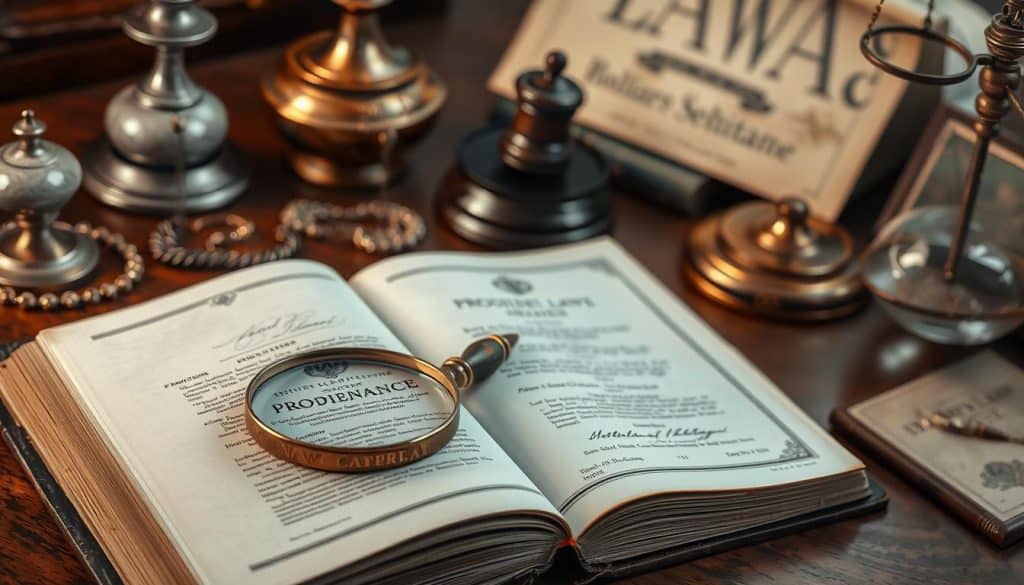
When looking for antiques, it’s key to know the legal rules. These rules change by place and tell us how to buy, sell, and move items. It’s important to have clear proof of where each item came from. This proof, called provenance, helps avoid buying stolen goods or items with unclear origins.
Collectors need to keep up with laws about cultural heritage and protecting artefacts. Some antiques might need special permits to leave the country or could be banned from being exported. Breaking these rules can lead to big fines or losing your items. Doing your homework helps you follow the law and avoid trouble.
Talking to lawyers who know about antiques is a smart move. They can guide you through tricky rules, check the item’s history, and explain the legal sides of owning such items.
| Aspect | Description |
|---|---|
| Provenance | History of ownership, crucial for establishing authenticity and legality. |
| Local Laws | Regulations governing the sale and purchase of antiques in specific regions. |
| International Laws | Global regulations concerning the trade of cultural heritage and antiques. |
| Legal Consultation | Engaging a legal expert can clarify complex antique laws and sourcing guidelines. |
Preserving antiques is key to keeping them valuable and intact. Different techniques are used based on the antique’s material. For wooden furniture, cleaning methods and protective coatings are crucial to fight moisture and insects. Waxing not only improves looks but also protects against the environment.
Textiles need a careful touch in antique care. Managing light and humidity is vital to avoid damage. Using acid-free materials and gentle cleaning helps extend the life of fabrics. Experts suggest regular checks and advice for the best care.
Metal antiques require special care too. Dusting and polishing with the right materials prevent rust. Applying protective coatings or using special rust inhibitors keeps them safe from damage.
Knowing how to preserve antiques is crucial for collectors. Regular upkeep and expert advice keep valuable items in great shape for years to come.
Trending Antique Styles and Collectibles in the UK
Antique trends in the UK are changing fast, showing new favourite styles and collectibles. Collectors and dealers are now looking for unique items that appeal to today’s tastes. This shift points to a bright future for antiques, with some eras and styles leading the way.
Popular Categories in Demand
Art Deco and mid-century modern items are top choices for collectors. Vintage clothes, ceramics, and retro furniture are also in high demand. These trends show how nostalgia and modern design are coming together.
- Art Deco: Known for its bold geometric patterns and luxury materials.
- Mid-Century Modern: Celebrated for its clean lines and functional form.
- Ceramics: Particularly pieces from renowned British potters.
- Vintage Clothing: Styles that evoke the charm and flair of bygone eras.
- Retro Furniture: Designs that bring a sense of warmth and character.
Forecasting Future Trends
Looking ahead in the antique world means watching the market closely. Experts study auction results, sales figures, and collector forums to spot new trends. Social media and public exhibitions also offer clues about what’s next in antiques.
| Collectible Category | Current Demand | Future Potential |
|---|---|---|
| Art Deco | High | Rising |
| Mid-Century Modern | High | Stable |
| Ceramics | Moderate | Increasing |
| Vintage Clothing | Moderate | Growing |
| Retro Furniture | High | Promising |
Creating a Network of Antique Enthusiasts
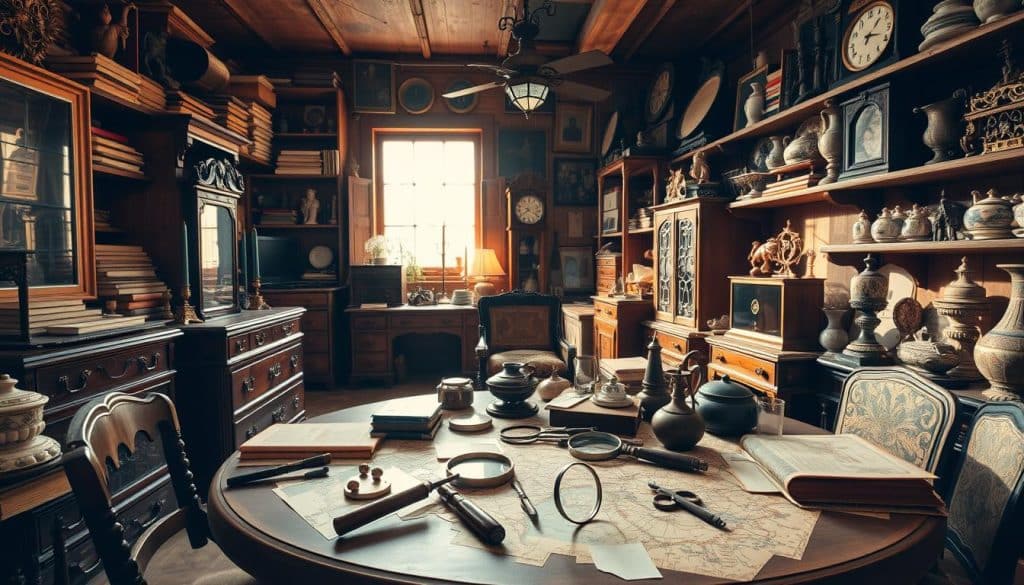
Building a strong network in the antique world has many benefits for collectors. It lets collectors share knowledge and learn about new trends and sources. Joining local antique clubs gives collectors a chance to meet others and feel part of a community.
Online forums and social media are great for making connections. By taking part in discussions or sharing stories, collectors meet others who share their interests. Going to seminars and fairs also helps build relationships with collectors and dealers, deepening one’s knowledge of antiques.
Having a network makes collecting more rewarding and opens doors to special tips and partnerships. Collectors often share advice on good sources or upcoming auctions, making finding antiques easier. This teamwork creates a lively community for serious collectors.
Putting effort into building and keeping up connections in the antique world is worth it. The friendships formed can lead to deeper insights and shared experiences. These are key for finding unique antiques.
Evaluating Antique Value: Expert Tips
Understanding how to value antiques is key for collectors and dealers. Many things affect an antique’s worth. Knowing these can help you understand how to appraise them. The main factors are age, rarity, condition, provenance, and market demand.
Factors Affecting Antique Valuation
Several important factors influence antique valuation:
- Age: Older items usually have more value if they are in good shape.
- Condition: The item’s condition greatly affects its value and appeal.
- Rarity: Items that are rare or hard to find can cost more.
- Demand: What collectors want can change the value of antiques.
- Provenance: Knowing who owned an item before can increase its value.
Getting Professional Appraisals
It’s important to work with certified appraisers for accurate valuations. They know how to look at all the factors that affect value. Appraisals are key for insurance, selling, or planning for the future. They also help collectors stay updated on market changes, keeping them informed about their collections’ value.
| Factor | Description | Impact on Value |
|---|---|---|
| Age | The length of time since the antique was made. | Higher if the piece is significantly old. |
| Condition | Physical state of the item, including wear and damage. | Better condition results in higher value. |
| Rarity | The availability of the item on the market. | Rare items usually have increased value. |
| Demand | Current popularity of the item among collectors. | Higher demand boosts value. |
| Provenance | Documented history of ownership. | Provenance can significantly increase value. |
Common Pitfalls in Sourcing Antiques and How to Avoid Them
Looking for antiques can be tricky and lead to mistakes. This part talks about common errors and how to avoid them.
- Misidentifying Fakes: Many collectors think they’ve found a real antique, but it turns out to be a fake. Not doing enough research can make you overconfident.
- Overpaying Due to Emotional Attachment: Emotional feelings can make you pay too much for something. Setting a budget and sticking to it helps avoid this.
- Neglecting Proper Research: Not looking into an item’s history and value is a big mistake. Using online resources, books, and experts can help you avoid this.
To do well in finding antiques, collectors need to be careful. Keeping up with market trends and joining groups of collectors can help a lot. This advice from others can be very useful in making smart choices and avoiding mistakes.
| Pitfall | Description | Prevention |
|---|---|---|
| Misidentifying Fakes | Error in recognising reproductions as genuine antiques. | Conduct thorough examinations and seek validations from experts. |
| Overpaying | Paying too much due to emotional attachment to the item. | Set firm budgets and limit emotional influence on purchasing decisions. |
| Neglecting Research | Insufficient investigation into an item’s background and market value. | Utilise resources such as books, online platforms, and expert advice. |
Rewarding Experiences: Stories from Successful Antique Collectors
Antique collecting is more than just making money; it’s a thrilling journey. Collectors share stories of finding rare items at auctions or hidden gems at fairs. These stories show the deep emotional and historical value of each piece.
Success in antiques brings people together. At antique fairs and workshops, collectors swap stories and advice. These gatherings create lasting friendships and mentorships, helping new collectors start their journey.
Collectors’ stories help us appreciate antiques more. They show that collecting antiques is about more than owning items. It’s about valuing history, making connections, and celebrating the stories each piece tells. These stories make collecting antiques a fulfilling experience for everyone involved.

